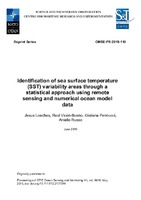| dc.contributor.author | Loeches, Jesus | |
| dc.contributor.author | Vicen Bueno, Raul | |
| dc.contributor.author | Pennucci, Giuliana | |
| dc.contributor.author | Russo, Aniello | |
| dc.date.accessioned | 2019-06-20T08:46:22Z | |
| dc.date.available | 2019-06-20T08:46:22Z | |
| dc.date.issued | 2019/06 | |
| dc.identifier.govdoc | CMRE-PR-2019-110 | en_US |
| dc.identifier.uri | http://hdl.handle.net/20.500.12489/850 | |
| dc.description.abstract | An understanding of environmental variability (stability/instability) is important to support operational planning of expeditionary warfare and littoral operations, as well as for preparing the Recognized Environmental Picture (REP). Specifically, the identification of environmentally stable/unstable areas helps the planning of maritime operations, increasing their likelihood of success. The purpose of the paper is to describe a methodology to form and interpret an initial spatial-temporal variability characterization of maritime areas from Remote Sensing (RS) and Numerical Ocean Model (NOM) data. As a case study, the analysis of the sea surface tem- perature (SST) in the Black Sea from historical time-series of RS imagery and NOM data is considered. The results of the analysis are validated with in situ measurements from moorings. Identification of gaps of geospatial information is also done in this study. The analysis is focused on monthly spatial-temporal variability of the SST, generating stability maps displaying the geospatial distribution of environmentally stable/unstable areas along a year. The results show how the proposed methodology captures the temporal variability of the SST in the Black Sea, being compared with in situ measurements, and provides useful information for the identification of environmentally stable/unstable areas. The results show a general agreement in the variability with both RS and NOM data, when RS imagery may be used for the present analysis, i.e. when low cloud coverage is given. This paper demonstrates that when RS imagery gaps are not negligible (e.g. due to high cloud occurrence in winter season), these gaps could be filled with NOM data. | en_US |
| dc.format | 13 p. : ill. ; digital, PDF file | en_US |
| dc.language.iso | en | en_US |
| dc.publisher | CMRE | en_US |
| dc.source | In: Proceedings of SPIE Ocean Sensing and Monitoring VII, vol. 9459, May 2015, doi: doi.org/10.1117/12.2177044 | en_US |
| dc.subject | Sea surface temperature (SST) | en_US |
| dc.subject | Remote sensing | en_US |
| dc.subject | Oceanography - Mathematical models | en_US |
| dc.subject | Physical oceanography | en_US |
| dc.subject | Meteorology | en_US |
| dc.subject | Black Sea | en_US |
| dc.title | Identification of sea surface temperature (SST) variability areas through a statistical approach using remote sensing and numerical ocean model data | en_US |
| dc.type | Reprint (PR) | en_US |
| dc.type | Papers and Articles | en_US |
